The U.S.’s approval of a BTC spot ETF strengthens BTC’s store-of-value narrative and its status as a macro asset. On the other hand, there are still unanswered questions surrounding ETH's fundamental positioning in the crypto space. Competing layer-one networks such as Solana have undermined ETH’s position as the network of choice for decentralized application (DApp) deployment. ETH's L2 expansion suite and the reduction in ETH burning also appear to be affecting the asset's value accumulation mechanism at a high level.
Nonetheless, we continue to believe that ETH's long-term positioning remains strong and it has important advantages that other smart contract networks do not have. These advantages include the maturity of Solidity's developer ecosystem, the popularity of its EVM platform, the utility of ETH as a DeFi collateral, and the decentralization and security of its mainnet. Additionally, we believe that advances in tokenization may have a more positive impact on ETH relative to other layer-one networks in the short term.
We found that ETH’s ability to capture the narrative of “store of value” and “technology token” is reflected through its historical transaction patterns. ETH has a high correlation with BTC, showing behavior consistent with BTC's store-of-value model.
At the same time, it will also decouple from BTC during long-term price increases of BTC, acting more like technology-oriented cryptocurrencies like other Altcoin. We believe that ETH will continue to fulfill these roles and is poised to perform well in the second half of 2024 despite underperforming year to date.
The multiple role classifications for ETH raise questions about its place in investment portfolios, and this article will clarify some of those claims and the potential upside for the asset in the coming months.
Response to the ETH controversy
ETH has been classified in various ways, from being considered an "ultrasonic currency" named for its supply reduction mechanism to being called an "internet bond" due to the non-inflationary nature of staking returns. (L2s) and the addition of re-pledge functions, new description methods such as "settlement layer assets" or more complex "universal objective work tokens" have emerged.
However, we believe these descriptions do not fully capture Ethereum’s vitality. In fact, as Ethereum's application scenarios continue to become richer and more complex, it has become increasingly difficult to fully assess its value through a single value indicator. What’s more, these different descriptions can conflict with each other, creating a negative effect as they can cancel each other out – distracting market participants from the positive drivers of the token.
ETH spot ETF
Spot ETFs are extremely important for BTC as they provide regulatory clarity and access to new capital inflows. These ETFs structurally change the industry and challenge the previous pattern of capital rotation from BTC to ETH to higher beta Altcoin. There is a barrier between capital allocated to ETFs and capital allocated to centralized exchanges (CEXs), which only have access to the broader crypto asset space.
The potential approval of a spot ETH ETF would remove this barrier, giving ETH access to the same capital pools that only BTC currently enjoys. In our opinion, this may be ETH’s biggest unanswered question in the near term, especially given the current challenging regulatory environment.
Although the SEC is silent on issuers, making timely approval uncertain, we believe the existence of a US spot ETH ETF is only a matter of when, not if. In fact, the main reasons for approving a spot BTC ETF also apply to a spot ETH ETF. That is, the correlation between CME futures products and spot rates is high enough that "CME's monitoring can reasonably be expected to detect inappropriate behavior in the spot market." The correlation study period in the spot BTC approval notice begins in March 2021, one month after the launch of CME ETH futures. We believe this evaluation period was chosen intentionally to apply similar logic to the ETH market. In fact, analysis previously presented by Coinbase and Grayscale suggests that spot and futures correlations in the ETH market are similar to those of BTC.
Assuming this correlation analysis holds true, the remaining possible reasons for disapproval may stem from the fundamental differences between ETH and BTC. In the past, we have discussed some differences in the size and depth of the ETH vs. BTC futures markets, which may have been a factor in the SEC's decision. But among other fundamental differences between ETH and BTC, we believe the most relevant approval issue is ETH’s proof-of-stake (PoS) mechanism.
As there is no clear regulatory guidance on the handling of asset staking, we believe it is unlikely that a spot ETH ETF that supports staking will be approved in the short term. The potentially obscure fee structures from third-party staking providers, differences between validator clients, complexity of slashing conditions, and liquidity risks of unstaking (and exit queue congestion) are materially different from BTC. (It’s worth noting that some ETH ETFs in Europe include staking, but generally, exchange-traded products in Europe differ from those offered in the U.S.) Nonetheless, we don’t think this should impact the status of unstaking ETH.
We think this decision may come as a surprise. Polymarket predicts a 16% chance of approval on May 31, 2024, while Grayscale Ethereum Trust (ETHE) trades at a discount of 24% to net asset value (NAV). We think the chance of approval is closer to 30–40%. As cryptocurrencies begin to become an election issue, we are also not sure whether the SEC is willing to invest the necessary political capital to support a decision to reject cryptocurrencies.
Even if the first deadline of May 23, 2024 is rejected, we think the likelihood of litigation overturning the decision is high. It is worth noting that not all spot ETH ETF applications must be approved at the same time. In fact, Commissioner Uyeda’s approval announcement regarding the spot BTC ETF criticized the disguised “motive for accelerating the approval application, namely to prevent first-mover advantage.”
Challenges of alternative L1s
At the adoption level, the integration of highly scalable suites, especially Solana, appears to be eroding ETH's market share. High-throughput and low-fee transactions have shifted the center of trading activity away from the ETH mainnet. It is worth noting that within the past year, Solana’s ecosystem has grown from accounting for only 2% of decentralized exchange (DEX) trading volume to now 21%.
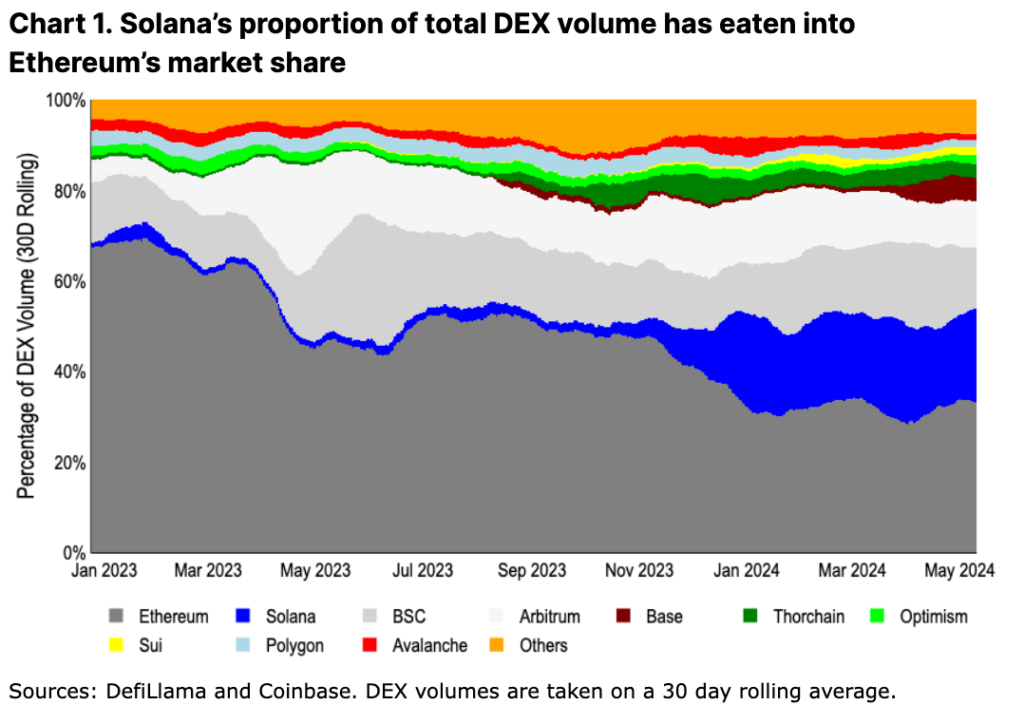
We believe alternative L1s also offer more meaningful differentiation now than during the last bull market. The move from the ETH Virtual Machine (EVM) and redesigning DApps from the ground up brings a unique user experience (UX) in different ecosystems. In addition, the integrated/monolithic extension kit approach enhances cross-application combination capabilities and avoids the problems of bridging UX and liquidity fragmentation.
While these value propositions are important, we believe it is premature to point to incentive campaign metrics as confirmation of success. For example, the number of trading users of some ETH L2s has dropped by more than 80% from the peak of the airdrop. At the same time, from Jupiter’s airdrop announcement on November 16, 2023 to the first claim date on January 31, 2024, Solana’s total DEX trading volume increased from 6% to 17%. (Jupiter is the leading DEX aggregator on Solana.) Jupiter has three rounds of airdrops yet to be completed, so we expect Solana DEX activity to continue for some time. In the interim, assumptions about long-term activity retention rates remain speculative.
Having said that, trading activity at leading ETH L2s such as Arbitrum, Optimism and Base now account for 17% of total DEX trading volume (plus 33% for ETH). This may provide a more appropriate comparison of ETH demand drivers versus alternative L1 solutions, as ETH is used as the native fuel token for these three L2s. Within these networks, other additional demand drivers for ETH are untapped, leaving room for future demand catalysts. We believe this is a more equivalent comparison of the integration versus modular extension kit approach in terms of DEX activity.
Another, more “sticky” measure of adoption is stablecoin supply. Stablecoin distributions tend to change more slowly due to bridging and issuance/redemption frictions. (See chart 2, same color scheme and arrangement as chart 1, Thorchain replaced by Tron) Activity is still dominated by ETH as measured by stablecoin issuance. In our view, this is because the trust assumptions and reliability of many new chains are not yet strong enough to support large amounts of capital, especially capital locked in smart contracts. Large capital holders are generally indifferent to ETH's higher transaction costs (relative to scale) and prefer to reduce risk by reducing liquidity pause times and minimizing bridging trust assumptions.
Even so, among high-throughput chains, the stablecoin supply of ETH L2s is growing faster than Solana. At the beginning of 2024, Arbitrum's stablecoin supply has surpassed Solana's (currently $3.6 billion vs. $3.2 billion), while Base's stablecoin supply has grown from $160 million at the beginning of the year to $2.4 billion. While the final verdict on the expansion suite debate is unclear, early signs of stablecoin growth may actually favor ETH L2s over alternative L1s.
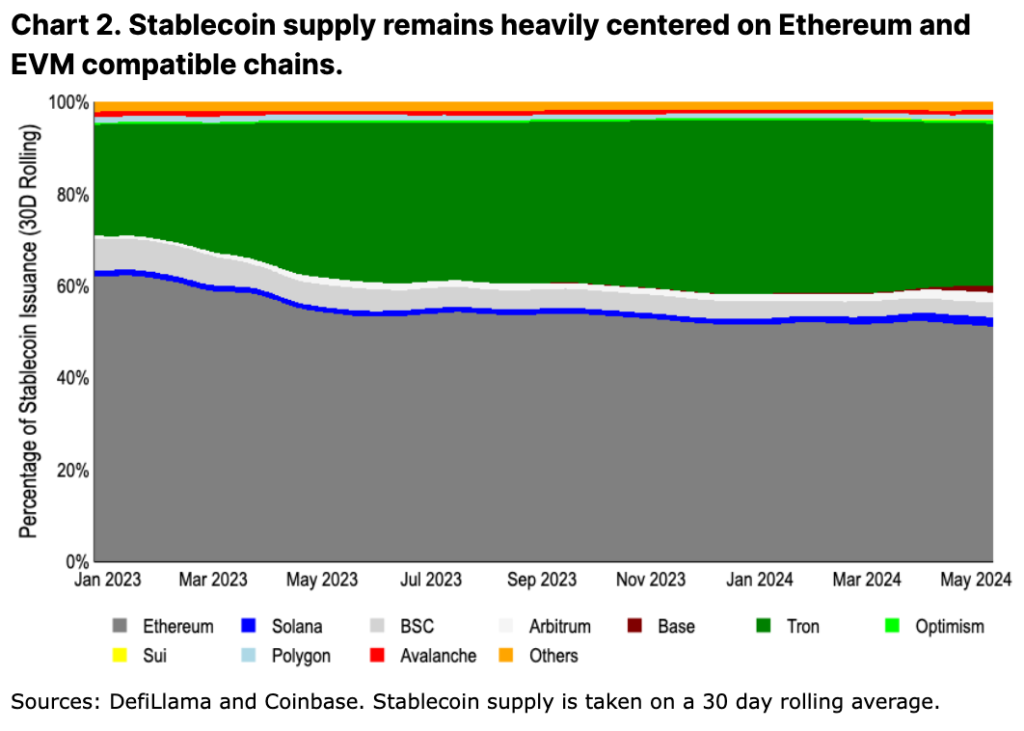
The growth of L2s has raised concerns about the real threat they may pose to ETH - they reduce the need for L1 block space (and therefore reduce the burning of transaction fees) and may support non-ETH gas tokens in their ecosystem (Further reducing the destruction of ETH). In fact, ETH has seen its highest annualized inflation rate since the move to a proof-of-stake (PoS) mechanism in 2022. While inflation is generally understood to be a structurally important component of BTC supply, we believe this does not apply to ETH. The entire ETH issuance is owned by the stakers, and since the merger, the collective balance of the stakers has far exceeded the cumulative ETH issuance (see Figure 4).
This is in stark contrast to BTC's proof-of-work (PoW) miner economics, where a competitive hash rate environment means miners need to sell a large portion of newly issued BTC to fund operations. While miners' BTC holdings are tracked in each cycle to cope with their inevitable selling, ETH's staking operating costs are the lowest, meaning pledgers can continue to increase their holdings. In fact, staking has become a convergence point for ETH liquidity - ETH in stake has grown by more than 20 times the amount of ETH issuance (not even including burns).
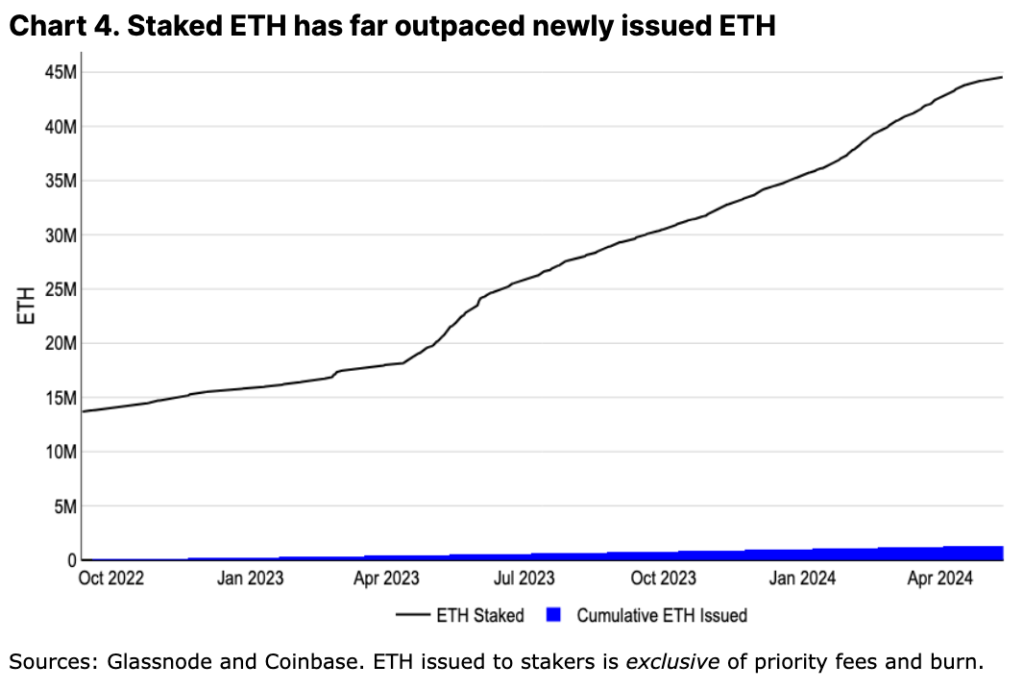
L2s itself is also a significant demand driver for ETH. More than 3.5 million ETH have been transferred to the L2 ecosystem, becoming another liquidity gathering point for ETH. Furthermore, even if the ETH transferred to L2s is not directly destroyed, the remaining balance of the native token held by the new wallet to pay transaction fees constitutes a soft lock on the growing portion of the ETH token.

Furthermore, we believe that some core activities will remain on the ETH mainnet forever, even with its L2s expansion suite. Things like EigenLayer’s re-staking activity or governance actions on major protocols like Aave, Maker and Uniswap remain firmly rooted in L1.
For users with the highest security concerns (generally the largest users of capital), it may also be possible to keep funds on L1 until a fully decentralized orderer and permissionless fraud proofs are deployed and tested - this A process that can take years. Even if L2s innovate in different directions, ETH will always be part of their treasury (used to pay L1 “rent”) and local unit of account. We firmly believe that the growth of L2s is not only beneficial to the ETH ecosystem, but also beneficial to ETH as an asset.
Advantages of ETH
Beyond the usual metric-based narrative covered, we believe ETH has other advantages that are difficult to quantify but equally important. These may not be short-term tradable narratives, but rather represent a set of long-term strengths capable of sustaining their current dominance.
Original Collateral and Account Units
One of the most important uses of ETH in DeFi is as collateral. ETH can be leveraged with minimal counterparty risk within ETH and its L2 ecosystem. It serves as a form of collateral in currency markets like Maker and Aave, and is also the underlying trading unit for many on-chain DEX pairings. The expansion suite of DeFi on ETH and its L2s has resulted in the aggregation of additional liquidity in ETH.
While BTC remains the primary store-of-value asset more broadly, using wrapped BTC on ETH introduces cross-chain bridges and assumptions of trust. We do not believe that WBTC will replace ETH in DeFi-based ETH usage – WBTC supply has remained flat for over a year and is more than 40% below its previous high. Instead, ETH can benefit from the diversity of its L2 ecosystem.
Continuous innovation and decentralization
An often overlooked component of the ETH community is its ability to continue to innovate even while being decentralized. Criticism has been leveled at ETH for its extended release schedule and development delays, but few acknowledge the complexities in weighing the goals and objectives of diverse stakeholders to make technological progress. Developers of more than five execution clients and more than four consensus clients need to coordinate the design, testing, and deployment of changes without causing disruption to mainnet execution.
Since BTC’s last major Taproot upgrade in November 2021, ETH has enabled dynamic transaction burning (August 2021), transitioned to PoS (September 2022), enabled staking withdrawals (March 2023), and provided support for L2 The extension set up blob storage (March 2024), and a series of other ETH Improvement Proposals (EIPs) are included in these upgrades. While many other L1s appear to be able to evolve faster, their single clients make them more fragile and centralized. The path toward decentralization will inevitably lead to a degree of rigidity, and it is unclear whether other ecosystems will be capable of establishing a similarly effective development process if and when they begin this process.
Rapid innovation at L2
This is not to say that ETH innovates slower than other ecosystems. Instead, we believe that ETH's innovation around execution environments and development tools actually outpaces its competitors. ETH benefits from the rapid centralized development of L2s, all of which pay settlement fees to L1. The ability to build a diverse platform with different execution environments (such as Web Assembly, Move or Solana virtual machines) or other features (such as privacy or enhanced staking rewards) means that L1's slow development schedule does not prevent ETH from being used in more Gain recognition in technically comprehensive use cases.
At the same time, the ETH community has worked hard to define different trust assumptions and definitions around sidechains, Validium, Rollup, etc., resulting in greater transparency in the field. For example, similar efforts in the BTC L2 ecosystem (such as L2Beat) have yet to materialize, where L2 trust assumptions vary widely and are often not well communicated or understood by the wider community.
Popularity of EVM
Innovation around new execution environments does not mean that Solidity and EVM will become obsolete in the near future. On the contrary, EVM has been widely spread to other chains. For example, many BTC L2 have adopted the research results of ETH L2. Some flaws in Solidity, such as the tendency to introduce reentrancy vulnerabilities, now have static tool checkers to prevent basic vulnerabilities. Additionally, the language's popularity has created a full-fledged audit department, an abundance of open source code samples, and detailed best practice guides. All of these are critical to building a large developer talent pool.
Although the use of EVM does not directly lead to the demand for ETH, changes to EVM are rooted in ETH's development process. These changes were subsequently adopted by other chains to maintain compatibility with EVM. We believe that the core innovation of EVM is likely to remain rooted in ETH or be preempted by L2 soon, which will focus the attention of developers and breed new protocols within the ETH ecosystem.
Tokenization and the Lindy Effect
The push for tokenization projects and increased global regulatory clarity may also benefit ETH first (in public blockchains). In our view, financial products are often more focused on technical risk mitigation than optimization and feature richness, and ETH has the advantage of being the longest-executing smart contract platform. We believe that higher transaction fees (dollars instead of cents) and longer confirmation times (seconds instead of milliseconds) are minor issues for many large tokenization projects.
Additionally, recruiting enough development talent becomes a key factor for more traditional companies looking to expand their kit business on-chain. Here, Solidity becomes the obvious choice because it constitutes the largest subset of smart contract developers, which also echoes the previous point about the popularity of EVM. Blackrock’s BUIDL fund on ETH and JPM’s proposed ERC-20 compatible Onyx Digital Assets Fungible Asset Contract (ODA-FACT) token standard are early signs of the importance of this talent pool.
structural supply mechanism
Active ETH supply changes significantly differently than BTC. Despite price increases since Q4 2023, ETH’s three-month circulating supply has not increased significantly. In comparison, we observed a nearly 75% increase in active BTC supply during the same time frame. Unlike what was seen in the 2021/22 cycle when ETH was still executed using Proof of Work (PoW), long-term ETH holders are not causing an increase in the circulating supply, but instead the growing ETH supply is being staked. This reaffirms our view that staking is a key liquidity convergence point for ETH, minimizing structural seller pressure on the asset.
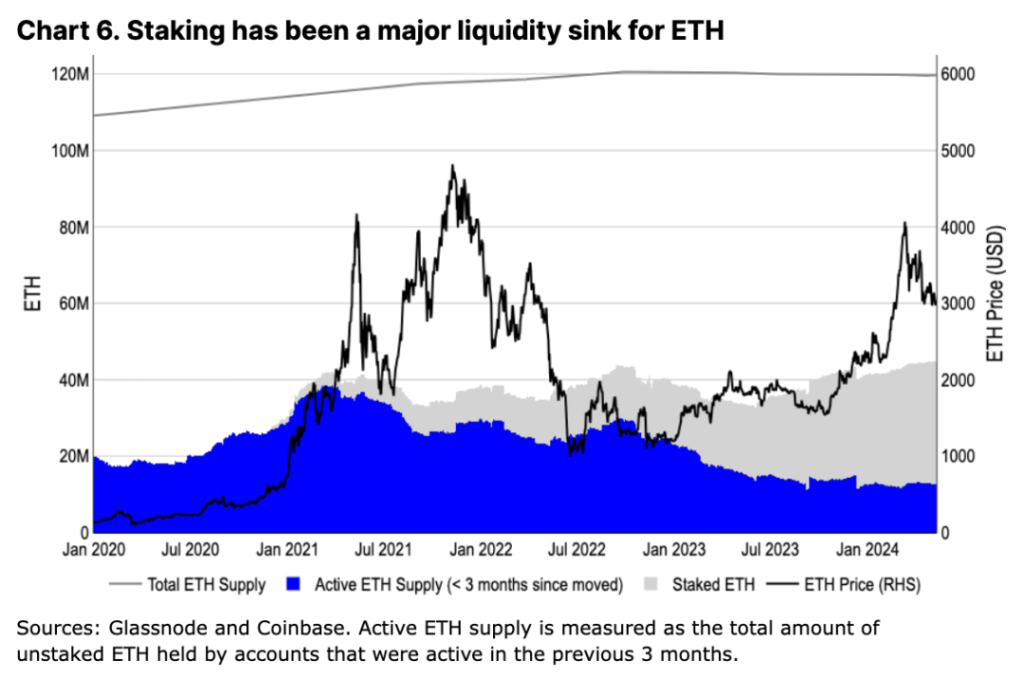
Evolving trading system
Historically, ETH has traded more in line with BTC than any other Altcoin. At the same time, it also decouples from BTC during bull market peaks or specific ecosystem events, a similar pattern observed in other Altcoin, albeit to a lesser extent. We believe this trading behavior reflects the market's relative valuation of ETH as a store of value token and a technology utility token.
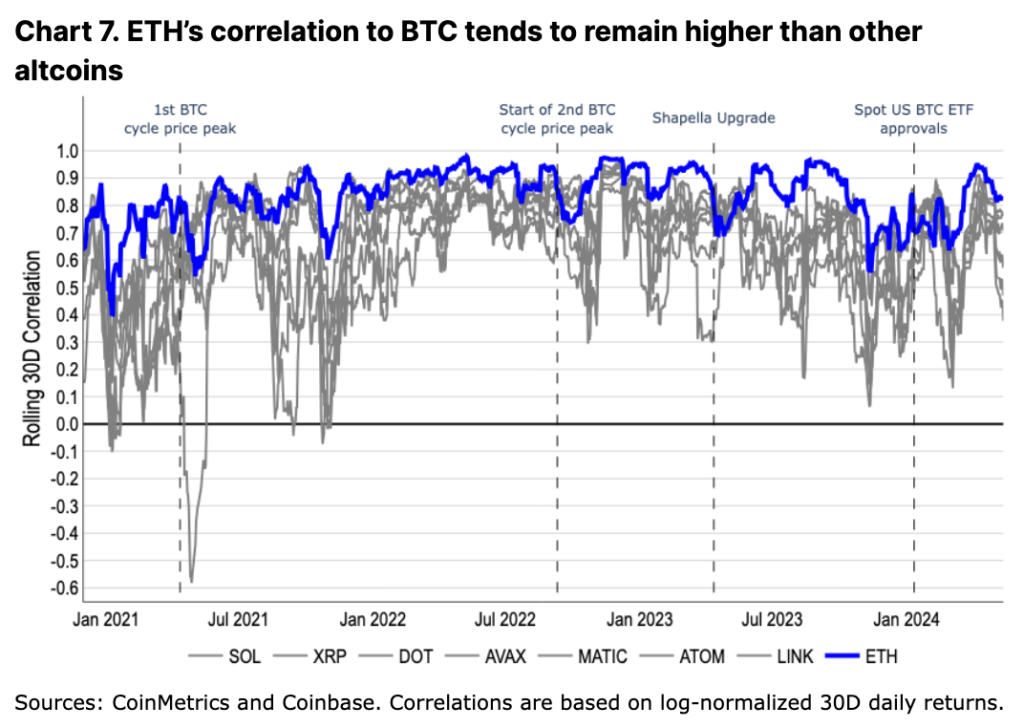
In 2023, the correlation between ETH and BTC will be inversely related to changes in BTC price. That is, as the value of BTC increases, ETH's correlation with it decreases, and vice versa. In fact, changes in BTC price appear to be a leading indicator of changes in ETH correlation. We believe this is the manifestation of market enthusiasm among Altcoin led by BTC prices, which in turn drives their speculative performance in bull markets (i.e. Altcoin trade differently in bull markets than perform relative to BTC in bear markets).
However, this trend has subsided following the approval of the US spot BTC ETF. We believe this highlights the structural impact of ETF-based inflows, where a whole new capital base has only exposure to BTC. New markets, such as registered investment advisers (RIAs), wealth management advisors and securities firms, may view BTC in their portfolios differently than many crypto-native or retail traders.
While BTC is the least volatile asset in a pure-crypto portfolio, it is often viewed as a small diversifier in more traditional fixed income and equity portfolios. We believe that this shift in BTC's utility has impacted the relative performance of its trading patterns versus ETH, and that ETH may see a similar shift (and recalibration of trading patterns) if a US spot ETH ETF is approved.
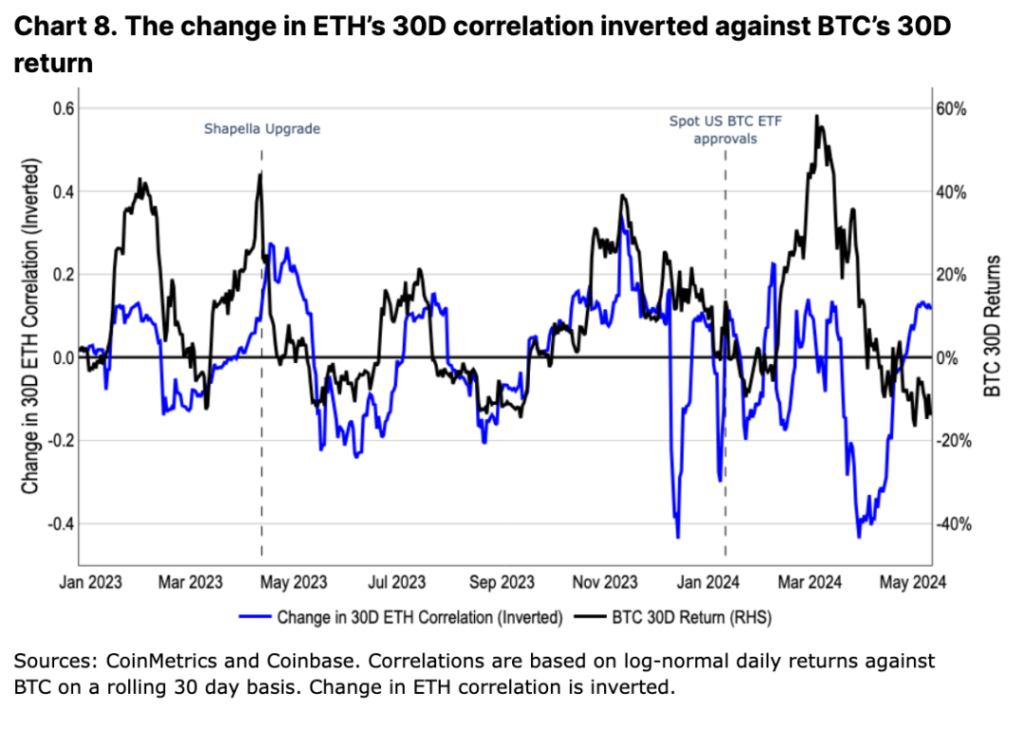
Summarize
We believe that ETH may still have upside potential in the coming months. There does not appear to be significant supply-side pressure on ETH, such as token unlocks or miner selling pressure. Instead, staking and L2 growth have proven to be meaningful and growing convergence points for ETH liquidity. We believe that ETH’s position as the center of DeFi is unlikely to be replaced due to widespread adoption of EVM and its L2 innovation.
Additionally, the importance of a potential US spot ETH ETF cannot be ignored. We believe the market may be underestimating the timing and likelihood of potential approvals, which provides upside. In the interim, we believe ETH’s structural demand drivers and technological innovation within its ecosystem will allow it to continue to juggle multiple narratives.








